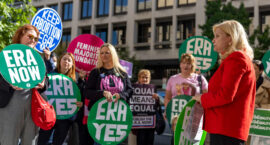At the Radical Optimism Conference on Jan. 26, hosted by former U.S. Rep Carolyn Maloney, political activists from around the state rallied for recognition of the federal ERA, made plans for securing a New York state constitutional amendment, plotted strategies for the 2024 elections and committed themselves to showing strong support by recruiting signers for the national ERA petition, Sign4ERA.org.
“In 2024, women’s rights will be on the ballot,” said Eleanor Smeal, president of the Feminist Majority.
“If equality and the Equal Rights Amendment, in particular, weren’t so important, they wouldn’t be fighting so hard to keep it from us,” said Zakiya Thomas, president of the ERA Coalition.
(This essay is part of “The ERA Is Essential to Democracy” Women & Democracy collection.)












